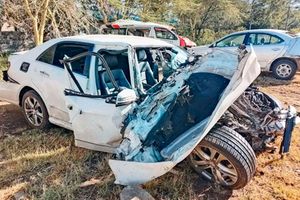Premium
House in Samburu where Uhuru was conceived

Kenyatta House in Maralal, Samburu County.
What you need to know:
- The house, located on the side of a hill a kilometre from Maralal town in Samburu County, has a rich history.
- It is where Kenya's founding President, Mzee Jomo Kenyatta, was partially detained.
- Mzee Kenyatta lived in the house for one year after he was transferred from Lodwar.
- Mama Ngina Kenyatta and two of her daughters — Christine and Jane Njeri — also lived in the house with Mzee.
“I was conceived in the house in 1961. A pleasure to be back using my two feet.” This is the most striking sentence in the visitors’ book in the historic house at the heart of Samburu.
The fact that the words were written by President Kenyatta on July 1, 2007, makes it even more fascinating.
Visiting Kenyatta House for the first time, you will be forgiven to think it is just another ranch in the bush.
The house, located on the side of a hill a kilometre from Maralal town in Samburu County, has a rich history. It is where Kenya's founding President, Mzee Jomo Kenyatta, was partially detained.
Five other politicians
Mzee Kenyatta lived in the house for one year after he was transferred from Lodwar, where, he had been detained together with five other politicians for agitating for independence.
Mama Ngina Kenyatta and two of her daughters — Christine and Jane Njeri — also lived in the house with Mzee.
The rusty wire mesh that rings the 28-acre land is diminishing due to vandalism, while the wobbly gate is not worthy of the national monument.
In stark contrast, opposite the house is the official home of Samburu Governor Moses Kasaine Lenolkulal, which has a permanent perimeter wall and a modern gate.
Mzee Kenyatta’s bedroom has a perfect view of Mt Kenya to the south.
When he visited the house in 2007 while still the MP for Gatundu and the official opposition leader, Mr Uhuru Kenyatta planted a cedar tree outside the house. The tree is now big and part of the canopy providing shade in the compound.
Renovations
The condition of the historic three-bedroom house is, however, set to change as the National Museums of Kenya (NMK) renovates it and its servants’ quarters.
It is one of the projects targeted by NMK as it revamps some sites and monuments countrywide.
The one-kilometre earth road leading to the house that is part of a rich history of the struggle for Kenya’s independence also needs to be upgraded and the signage from Maralal town made visible to first-time visitors.
When complete, the site will have a new sentry box and a modern ablution block for visitors.
“We’re doing renovations and painting the house, and everything Mzee Kenyatta used will remain intact for future generations to see,” Mr John Rigano, the curator of the house, sasid.
Charcoal iron box
Exhibits include photographs, a charcoal iron box, the original black telephone, furniture of the Kenyatta family, and Mzee’s spring bed with a sisal mattress that has the colonial detention colours of blue and white stripes.
The kitchen has an oven that used firewood to heat water to the bathroom, which has a bathtub.
The living room is intact, with a dining table and six canvas chairs and a smaller table with four chairs next to the fireplace.
Wardrobes and spring beds in the three bedrooms, with sisal mattresses, are still in good condition.
The green and beige colours of the house are original, albeit with retouches of fresh paint over the years.
The house is not connected to electricity, and hooks on the walls indicate that Mzee Kenyatta used lantern lamps to light the house.
Plans are underway to build cottages for visitors to relax as they watch wild animals such as zebras, which roam the grounds.
“We’ve started with the first phase of renovations of the main house. The second phase of repairs will involve construction of a site where we shall have a modern exhibition site of the culture of communities living in Samburu and an entertainment area for visitors,” the curator said.
Documented history
The site will also have documented history of the struggle for independence.
“We shall have both written and visual history of the struggle for independence and visitors walking around the house will follow it with ease,” Mr Rigano said.
“In the second phase of renovations, we intend to have a screen in each room that will display the history of the struggle for independence and visitors will have a few moments to reflect as they tour the house,” he added.
“There is a lot of research going on … researchers are digging the archives and writing history that will be electronically displayed in this house.”





